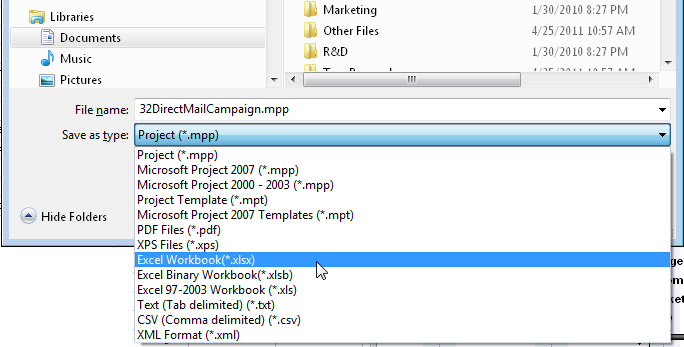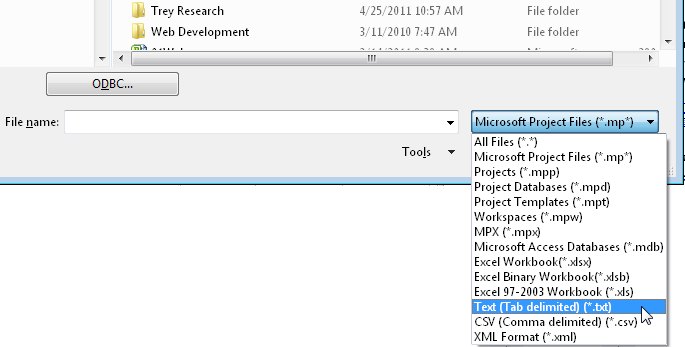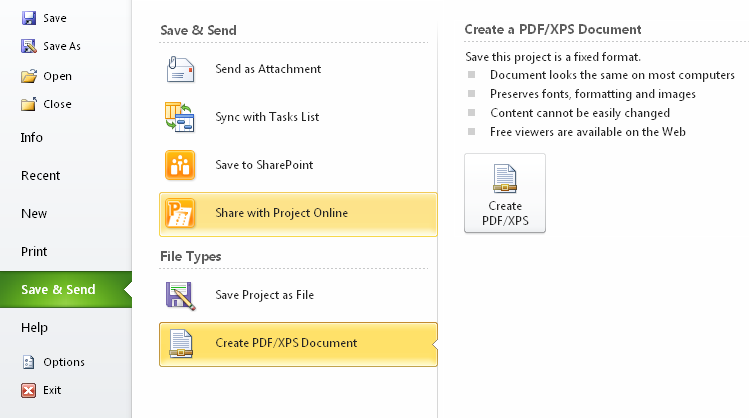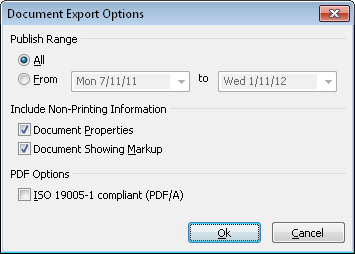A file format is an arrangement of data in a file that specifies the file type and defines the file properties in such a way that its resident application or any compatible application can open the file correctly. When you create and save a regular Microsoft Project file, it’s saved as an MPP file. The file name’s .mpp extension indicates that this is indeed a regular Microsoft Project file.
However, you can save, or export, project files to other file formats. You can also open, or import, files from other file formats in Project 2010. In most cases, you carry out, or at least start, the exporting process from the Save As dialog box and the importing process from the Open dialog box.
To save a project file as a different file format than the standard MPP format, follow these steps:
With the file open in Project 2010, on the File tab, click Save As.
If the file format converts a single view rather than the entire file, display the view you want to export.
Browse to the drive and folder where you want to save the file.
Click the arrow in the Save As Type box.
Click the file format you want.
Click Save.
In some cases, another process such as export mapping might start. In other cases, you might see a dialog box asking for more information. In most cases, however, the file or view is simply saved in the selected format.
To open a file in Project 2010 that’s in a different file format than MPP, follow these steps:
In Project 2010, on the File tab, click Open.
Browse to the drive and folder that contain the file you want to import into Project 2010.
Click the arrow in the button currently labeled Microsoft Project Files (*.mp*) next to the File Name box.
Click the file format of the file you want to import.
All files of that format in the current folder are listed in the dialog box.
Double-click the file you want to import.
In some cases, another process such as import mapping might start. In most cases, however, information from the imported file simply opens in Project 2010.
Table 32-1 details the file formats supported by Project 2010 for saving, opening, or both. Unless otherwise noted, the file formats listed can be accessed from the Save As Type box on the Save As dialog box or the Files Of Type box on the Open dialog box.
Table 32-1. Supported File Formats
Extension | Save or Open | Notes | |
|---|---|---|---|
Project | .mpp | Save Open | Saves or opens the file as a Microsoft Project Plan file, which is the default file type for projects being opened or saved in Project 2010. |
Microsoft Project 2007 | .mpp | Save Open | Saves or opens the file as a Microsoft Project Plan file using the file format from Microsoft Project 2007. |
Microsoft Project 2000-2003 | .mpp | Save Open | Saves or opens the file as a Microsoft Project Plan file using the file format from Microsoft Project 2000, 2002, and 2003. |
MPX | .mpx | Open | Opens a Microsoft Project Exchange (MPX) file created in Microsoft Project 98 or an earlier version. This is a record-based ASCII text-file format that Project 2010 can read, allowing earlier Microsoft Project files to be opened and converted to Project 2010 files. |
Project Template | .mpt | Save Open | Saves the file as a Microsoft Project template file that can then be used as a basis for new projects. Opens a template file. You can change and save those changes to the template file. |
Microsoft Project 2007 Templates | .mpt | Save Open | Saves the file as a Microsoft Project 2007 template file that can then be used as a basis for new projects in Microsoft Project 2007. Opens a template file. You can change and save those changes to the template file. |
Project Workspaces | .mpw | Save Open | Saves all open project files as a Microsoft Project workspace file. Available through the Save Workspace command that can be added to the Quick Access Toolbar or ribbon. Opens a Microsoft Project workspace file, which opens all associated projects in a single step. |
PDF Files | Save | Saves the current view as a PDF (Portable Document Format) file. Ensures that the view is preserved with its original formatting and is not editable. A PDF file is also easy to open and read using a free downloadable reader on any computer. | |
XPS Files | Save | Saves the current view as an XPS (XML Paper Specification) file. Ensures that the view is preserved with its original formatting and is not editable. An XPS file is also easy to open and read on any computer by using a free downloadable XPS viewer. | |
Excel Workbook | .xlsx | Save Open | Saves specified project fields as Microsoft Excel data so that the file can then be opened in Microsoft Excel 2007 or 2010. Opens, through the import process, an Excel 2007 or 2010 workbook in Project 2010. |
Excel Binary Workbook | .xlsb | Save | Saves specified project fields in the Excel 2007 Binary File Format (BIFF12). |
Excel 97-2003 Workbook | .xls | Save Open | Saves specified fields as Microsoft Excel data so that the file can then be opened in Microsoft Excel 97-2003. Opens, through the import process, an Excel 97-2003 workbook in Project 2010. |
Text (Tab Delimited) | .txt | Save Open | Saves fields from a single Project 2010 table as a text file. A tab-delimited text file uses tabs to separate fields of data in a record. Opens a tab-delimited text file which can be imported into a Project 2010 table. This is ideal for using project information in a third-party application or on another operating system. |
Text (Comma Delimited) | .csv | Save Open | Saves fields from a single Project 2010 table as a text file. A comma-delimited text file uses commas to separate fields of data in a record. Opens a comma-delimited text file that can be imported into a Project 2010 table. This is ideal for using the project information in a third-party application or on another operating system. |
XML Format | .xml | Save Open | Saves a project file as eXtensible Markup Language (XML) data. The structure of the resulting file is determined by the Project 2010 XML schema. Opens an XML file in Project 2010. For Project 2010 to understand and open it, an XML file must conform to the Project 2010 XML schema. |
Project Databases | .mpd | Open | Opens a legacy Microsoft Project database. |
Microsoft Access Databases | .mdb | Open | Opens a Microsoft Access database file in Project 2010. |
Open Database Connectivity | Open | Opens a database file created in ODBC-compliant Microsoft SQL Server databases. To open an ODBC file, click the ODBC button in the Open dialog box and follow the instructions in the Select Data Source dialog box. |
Note
Previous versions of Microsoft Project provided the ability to save Project data to an Excel PivotTable. This feature is no longer available in Project 2010. However, you can still create Excel visual reports that use your project data in an Excel PivotTable format. For more information, see Producing a Visual Report of Project Data in Excel.
In Project 2010, the MPP file format for regular project files is updated. However, you can easily open project files created in earlier versions of Microsoft Project. If the file was created in Microsoft Project 98 through Microsoft Project 2007, you can open it in Project 2010 with no conversion required.
If the project file was created in a version earlier than Microsoft Project 2000, the file must first be saved in the MPX (Microsoft Project eXchange) format. Project 2010 can then open the MPX file and save it as a Project 2010 file. The MPX file format is a record-based ASCII text-file format and is available in the Save As and Open dialog boxes.
To open a Project 2010 file in an earlier version of Microsoft Project, the file must first be saved in the appropriate Microsoft Project file format. In the Save As dialog box, you can specify that a file be saved in the Microsoft Project 2007 format or the Microsoft Project 2000-2003 format.
You can save a project file as a template file (MPT), which can then be used as a basis for new projects.
Note
For more information about working with project templates, see Working with Project Templates.
You can export project information to an Excel spreadsheet. This process starts in the Save As dialog box and ends up in the Export Wizard, where you map corresponding fields between Project and Excel.
Likewise, you can import Excel information into a project plan. The process starts in the Open dialog box and ends in the Import Wizard, again to map pairs of corresponding fields between Project and Excel.
Note
For more information about importing and exporting with Excel and other applications, see Importing and Exporting Information.
Because a project file is essentially a database collection of fields and records, it makes sense that you can convert Project 2010 information to and from database applications.
There are three ways to exchange project information with a database:
Save the project file in XML format
Save to or open from an ODBC (Open Database Connectivity) database file
Save the project file as a Microsoft Access (MDB) file
To save a project file in XML format for subsequent use in a database, follow these steps:
With the project file open in Project 2010, on the File tab, click Save As.
Browse to the drive and folder where you want to save the new XML file you’ll be creating.
Click the arrow in the Save As Type box, and then click XML Format.
If you want, change the name in the File Name box.
Click Save.
The structure of the resulting file is determined by the Project 2010 XML schema.
To save a project file as an ODBC database, first open the project file you want to convert. On the File tab, click Save As. Click the ODBC button, and then work through the Select Data Source dialog box.
To open an ODBC database, on the File tab in Project 2010, click Open. Click the ODBC button, and then work through the Select Data Source dialog box.
You can save reporting data from a project file as a Microsoft Access MDB file through the Visual Reports dialog box. To do this, follow these steps:
On the Project tab, in the Reports group, click Visual Reports.
Click the Save Data button at the bottom of the Visual Reports - Create Report dialog box.
Under Save Reporting Database, click Save Database.
In the Save As dialog box that appears, browse to the location where you want to save the database. Give the file a name, and then click Save.
The reporting data in your project file is gathered and saved as an Access (MDB) file. You can then open the file in Access.
To open a Microsoft Access MDB file in Project 2010, follow these steps:
In Project 2010, on the File tab, click Open.
Browse to the drive and folder that contain the Access database file you want to import into Project 2010.
Click the arrow in the button currently labeled Microsoft Project Files (*.mp*) next to the File Name box.
Click Microsoft Access Databases (*.mdb).
All MDB files in the current folder are listed in the dialog box.
Double-click the file you want to open.
You can save or open information from several file formats especially designed to work across different applications and even different operating systems. This means that you can still exchange information with a program for which there is not an explicit file format. These common cross-application file formats available in Project 2010 are:
TXT (tab-delimited text)
CSV (comma-separated value text)
XML (eXtensible Markup Language)
PDF (Portable Document Format)
XPS (XML Paper Specification)
Both the TXT and CSV text file formats allow for text transfer between applications. If the text is in table format, the TXT format separates the fields with tabs, whereas the CSV format separates the fields with commas. When you import a TXT or CSV file into a table format, the fields separate into columns according to the tabs or commas.
The XML format provides a self-defining, adaptable language that’s used to define and interpret data in different applications, particularly in web-based documents. An accompanying XSL style sheet is used to work with and interpret the XML file.
Note
For more information about working with the XML file format, see Working with Project 2010 and XML Files in Chapter 17.
New in Project 2010 is the ability to save an active view as a PDF or an XPS file. No other program needs to be installed to create these files. With either of these programs, you can ensure that your file preserves its original formatting and is not editable. You can save, send, post, or print these views.
A PDF file can be opened by any computer using the free, downloadable Adobe Reader. An XPS file opens in the browser of most Windows computers. This makes these files easy to open and read on any computer. This is especially important because you can’t assume that everyone who needs to see your project information has access to Project 2010.
To save a view as a PDF or an XPS file, follow these steps:
In Project 2010, open the view and arrange the data as you want it to appear when its printed.
Note
For more information about available views and arranging information in those views, see Chapter 4.
On the File tab, click Save & Send.
In the Save & Send Backstage view, click Create PDF/XPS Document.
The right pane displays information about PDF/XPS documents, as shown in Figure 32-5.
In the right pane, click Create PDF/XPS.
Browse to the location where you want to save the file.
Enter a name in the File Name box.
If you want to create an XPS file instead of the default PDF file, click in the Save As Type box, and then click XPS Files (*.xps).
Click OK.
Make any necessary changes in the Document Export Options dialog box, as shown in Figure 32-6, and then click OK.
Instead of using the Save & Send Backstage view, you can also save a project view as a PDF or an XPS file by clicking File, Save As, and then selecting PDF Files (*.pdf) or XPS Files (*.xps) in the Save As Type box.
Note
For information about PDF reports, see Saving a Report as a PDF File.




